Italian Navy for the Serbian Army in the Great War

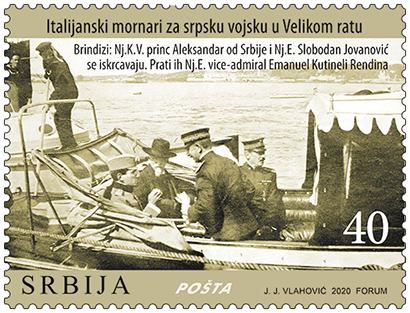






In the middle of the winter of 1915/1916 the Serbian Army, in the jaws of the army of the Central Powers, was forced to retreat followed by masses of people. On the Albanian coastline of the Adriatic they were all saved thanks to the magnificent humanitarian-military operation of the Italian Royal Navy. From December 12, 1915 to February 29, 1916 the Ita-lian Navy evacuated from Albania: 260,895 Serbian soldiers and refugees, 24,000 Austrian soldiers – prisoners of war of the Serbian Army, 10,153 horses, 68 cannons and 300,000 tons of food and supplies. Along with the Serbian Army and people, the Serbian Parliament, Government, Church, head of the Military, King, archives and treasures were evacuated. A total of 248 water crossings were conducted utilizing 350 ships. After long years of grueling trench warfare, only the Serbian Army was able to break through the Salonika Front and with continuous progress it determined the victory of the Allies in the Great War. But there would not have been that victorious Serbian Army if a few years earlier the Italian Royal Navy had not been on the coasts of Albania to extend a helping hand and deliver it to safety. The evacuation of the Serbian Army and people is a precursor to today’s humanitarian operations and still remains recorded as the most important and most complex operation of international humanitarian assistance and rescue of all time
By issuance of appropriate postage stamps on the Centennial of conclusion of the Paris Peace Conference, we pay tribute to those who sacrificed their own lives to save hundreds of thousands of civilians and soldiers. This is the best way to recall the enormity of the tragedy of war, even when it inspires such extraordinary episodes of solidarity and friendship of two peoples.
Motifs on the stamps: 27 RSD – Medua: Italian ships were waiting for them; 40 RSD – Brindisi: His Royal Highness Prince Aleksandar of Serbia and His Excellency Slobodan Jovanovic unloading. Accompanying them His Excellency Vice Admiral Emanuele Cutinelli Rendina, Commander of Operations for the transport of the Serbian Army; 54 RSD – Brindisi: Serbian Field Marshal Radomir Putnik disembarking from an Italian anti-torpedo boat; 70 RSD – Brindisi: Serbian officers disembarking
Motifs on the vignettes: 1 – Arta near Vlora: Wounded Serbs with medical staff; 2 – Durres: To the Italian ships, the ships of salvation; 3 – Serbian refugees disembarking at an Italian port; 4 – Bari: Serbian wounded disembarking at the italian port.Expert collaboration: Mila Mihajlovic, Ph.D. historian, author of the Project “For the Serbian Army – The Forgotten Story”
Graphic realization of the stamps: MA Jakša Vlahović, academic graphic artist
Expert collaboration: Mila Mihajlovic, Ph.D. historian, author of the Project “For the Serbian Army – The Forgotten Story”
Lunar Horoscope – year of the rat
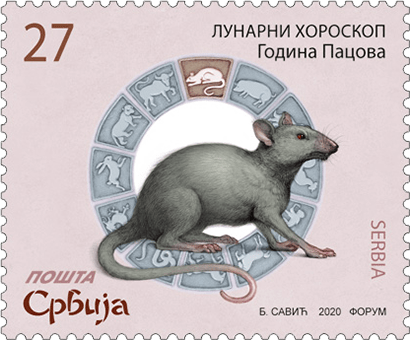





The lunar calendar is based on cycles of lunar phases, although most of the lunar calendars are actually lunisolar calendars. This means that the calendar months correspond to lunar cycles; however, intercalary months are occasionally added to harmonize these cycles with the solar year. Among these calendars are Chinese, Hebrew and Hindu calendars, as well as most calendar systems used in ancient times. Lunar calendars differ according to which day the month begins. In the Chinese calendar, the first day is astronomically determined by the conjunction of the Sun and the Moon in the Chinese time zone.
Chinese Zodiac belongs to the oldest known astrological systems. It consists of 12 signs, each of which rules over one lunar year. These zodiac signs bear the names of animals (Rat, Ox, Tiger, Rabbit, Dragon, Snake, Horse, Goat, Monkey, Rooster, Dog and Pig). In addition to the basic signs, elements are also quite important in Chinese horoscope: wood, metal, water, fire and earth. Chinese astrology is based on the knowledge of ancient astronomers and the traditional Chinese calendar. It is also associated with ancient teachings about three harmonies – heaven, earth and water, Wu Xing teachings, Yin and Yang, five planets, 10 celestial streams and 12 earth branches, etc.
According to the lunar horoscope, 2020 is the year of the Rat and it begins on Saturday, January 25th. Persons born under this zodiac sign are intelligent, energetic, and they can adapt to any situation, solving each problem with ease. The inherent confidence, charm, hard work, discipline and passionate dedication give people born in this sign a great chance to have a successful career and even get rich.
According to the lunar horoscope, 2020 will be a year of new beginnings. The Year of the Rat will be strong and prosperous for all signs of the lunar horoscope, so determination should be shown in achieving the goals, because the Year of the Rat is excellent, both for new beginnings and for development and advancement in general.
Artistic realization: MA Boban Savić, academic painter.
Easter






Easter Sunday is the date of the annual celebration of Christ’s resurrection. The date is not fixed, but denotes the same season of the year and the same relationship to the preceding astronomical full moon that occurred at the time of His resurrection in 30 A.D.
Easter is one of the most important Christian holidays. This is a day of eternal joy, the day when Christ, the Son of God, conquered the death. By the act of resurrection Jesus Christ proved his divine power and opened the gate of eternal life, joy and happiness that we can find in our faith.
On Easter Sunday morning the church bells toll, and the people, together with their priest, go around the church. After the third round they stand in front of the church door. The priest carries the cross, candle and the censer and chants the Easter hymn. The door open and they enter the church where liturgy continues. When it ends, people greet each other with the words: “The Christ has resurrected”, and “Indeed he has”. There are many customs connected with Easter Sunday, and certainly one of them that children like best, is colouring and offering of eggs. The first egg is coloured red and in many parts of our country it is called “The house keeper” and is kept for the whole year, until the next Easter.
Expert collaboration: The Museum of the Serbian Orthodox Church in Belgrade.
Artistic realization of the issue: MA Nadežda Skočajić, academic graphic artist.
180th Anniversary of the Post of Serbia

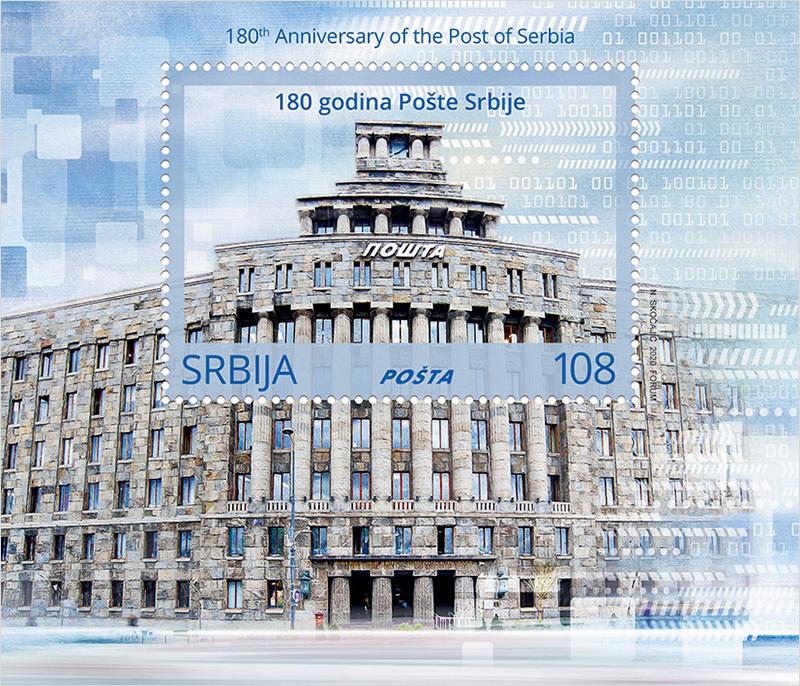

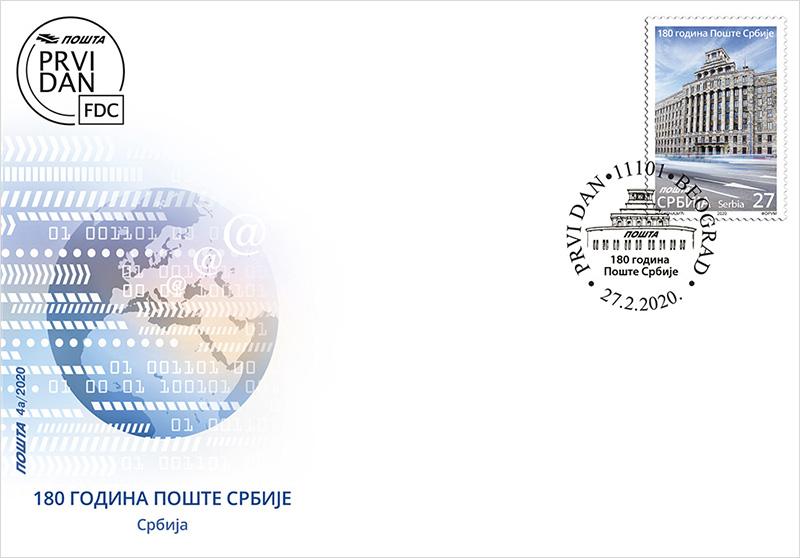


At the territory of Serbia, ever since ancient times until the 19th century, there had always been a network of objects and people organized for transmission of letters, for the needs of state administrations. However, the citizens of those states could not use this network for their private purposes. According to Sretenje Constitution (1835) and the Constitution from 1839, the Ministry of Internal Affairs was assigned to establish public postal traffic in Serbia. The Ministry employed its business space and its clerks in order to open the first post office in Belgrade on 25 May / 7 June 1840, and soon afterwards the other post offices in Serbia.
The Postal Administration, as a department within the Ministry of Internal Affairs, initially had only 17 clerks, post masters and 16 post masters in Serbian towns. Those were the pioneers of the great system which, at the beginning of the 21st century, had 17,000 employees engaged in postal traffic. In the meantime, the Serbian Post was the first institution in Serbia which in 1891 trained, and in 1892 employed women – the first female post clerks
In 180 years these people conveyed billions of postal items, among which there were millions of postal items from different culture fields – books, magazines, vinyl records and discs, film rolls, works of art... Even at the beginning, the Serbian Post had understood the value of literacy, and culture in general, so the conveyance of newspapers and books for Serbian readers, from 1846 was free of charge.
Many notable citizens of Serbia worked at the Post – Đura Daničić, Milovan Glišić, Vojislav Ilić, Dragomir Brzak, Branislav Nušić, Todor Stefanović Vilovski...
With its continuous existence the Post of Serbia also represents a confirmation of continuity of the modern Serbian state and it is an indicator of technological progress and modern aspirations of Serbia – from printing of the first postage stamps in 1866, via participation in the founding of the Universal Postal Union in Berne in 1874, the introduction of the telegraph in 1855 and the telephone in 1883, the establishment of Telekom Srbija a.d. 1997, until the opening of the most modern Regional Postal and Logistics Centre Belgrade in 2014, which achieved a higher level of quality of existing services and introduction of new ones in domestic and international postal traffic, especially in the segment of logistics services and electronic commerce.
The Post of Serbia enters its 180th year of existence laureled by numerous awards and recognitions and it continues to act as an important part of the modern national history of Serbia.
Public Enterprise Post of Serbia
Artistic realization of the issue: Nadežda Skočajić, academic graphic artist.
Renowned Serbian Personalities


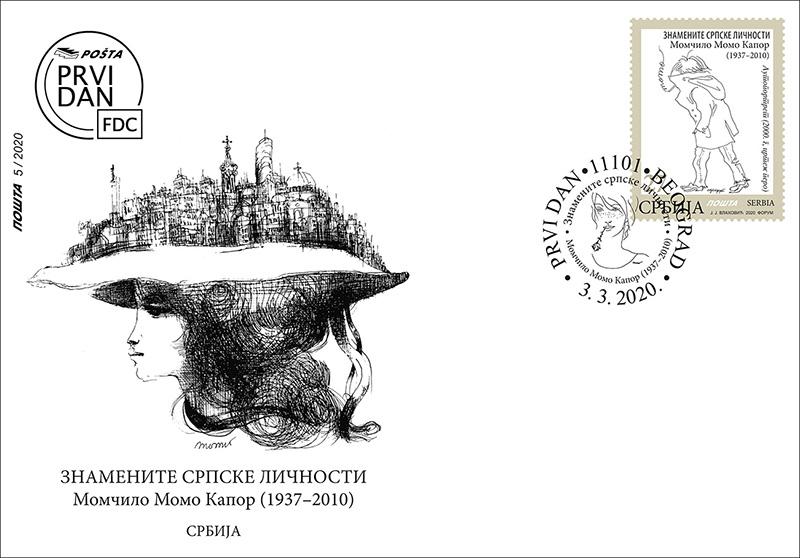

Momčilo Momo Kapor (1937–2010)
Momčilo Momo Kapor (8 April 1937 – 3 March 2010) was born in Sarajevo and moved to Belgrade when nine years old, where he lived the rest of his life with short interruptions. He graduated in 1961 at the Belgrade Academy of Fine Arts with a degree in painting, in the class of Nedeljko Gvozdenović. He entered the literary life of the capital in early 1960s, and published more than fifty books since – novels, short stories, travelogues and artistic monographies, making a plethora of works that were produced and played in theatres, on radio and TV. He was different from the other Belgrade writers in that he illustrated his books himself, nurturing an exceptional, lyric drawing style. He displayed his paintings in galleries and museums of Belgrade, Novi Sad, Zrenjanin, Zagreb, New York, Boston, Geneva, Brussels, Udine, Frankfurt, Caracas, London, Paris…The literary critics and theoreticians considered him as one of the founders of the so-called “jeans prose” in our literature, pointing out his mastery in short literary forms. He was the author of the following novels: “Pretenders”, “Provincials”, “Ada Islet”, “Zoe”, “Green Felt of Montenegro”, “The Sarajevo Trilogy (The Last Flight to Sarajevo, Chronicle of the Lost City and The Address Keeper)”, “Ivana”, “Conte”, “Case History of Šlomović”, “Confessions”, “Travelogue through Biography”, “How to Become a Writer”, and so on. “Hello Belgrade”, “Magic of Belgrade” and “The Guide Through the Serbian Mentality” write about Belgraders, their city and life in it. His stories and novels were collected in several collections: “Death Doesn’t Hurt”, “She and Off Stories”, “101 stories”, “The Best Years and Other Stories”.Momo Kapor is also the author of a great number of documentaries and TV programmes, and several feature-length movies were made by his screenplays. His works were translated into French, German, Polish, Czech, Hungarian and Swedish language.He was a full member of the Academy of Science and Art of the Republic of Srpska.
Motif on the stamp: “Self-portrait” (2000, drawing, quill); motif on the vignette: “Portrait of Liki” (1982, drawing, pencil); motif on envelope: “Belgrade on the Hat” (2006, drawing, quill); motif on the cancellation: “A Girl with Rose” (1996, drawing, quill).
Expert collaboration: Momčilo Momo Kapor Foundation.
Graphic realisation of the issue: MA Jakša Vlahović, Academic Graphic Artist.
Cities of Serbia
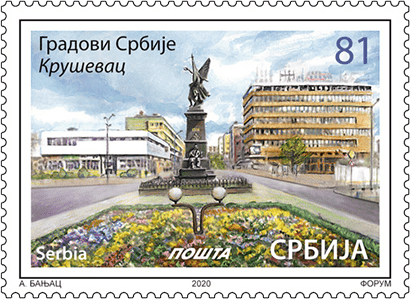








Kruševac
Kruševac is a city of exceptionally rich cultural and historical heritage. History in this city began to be written back in 1371, when Prince Lazar built Kruševac, choosing it for his capital.
Within the complex of Lazar’s Town, there is the Lazarica Church, which was dedicated by Prince Lazar to the Archdeacon and Martyr Stefan, the patron saint of the Nemanjić dynasty, and in honor of his firstborn son Stefan. There, the Serbian army took communion before going to the Battle of Kosovo. Not far from it, on the Square of Despot Stefan, a monument to Princess Milica by Zoran Ivanović, an academy-trained sculptor, was erected in 2018.
The City Government building (Načelstvo) with its magnificent interior represents one of the most beautiful architectural works from the beginning of the 20th century located in Kruševac. Mosaic Complex In Honour of Kruševac – the work of Mladen Srbinović inspired by the medieval history of Serbia, which adorns the premises of Načelstvo, consists of the wall and floor mosaics, stained glass windows and lunettes in the ceiling niches.
One of the oldest buildings in Kruševac is the Simić House, built before 1833, known as the place where Mileta’s rebellion was arranged. The centre of Kruševac is dominated by the symbol of the city – the Monument to the Kosovo Heroes, by sculptor Djordje Jovanović, which was awarded the Gold Medal of I Order at the 1900 Paris Universal Exhibition.A memorial complex dedicated to the people from Kruševac and the surroundings who were shot in World War II – Slobodište, is located in the southern outskirts of the city. In the immediate vicinity of the town there is the Jastrebac Mountain, whose highest peaks Đulica (1491m) and Pogled (1481m) represent the natural boundary between Toplica and Pomoravlje regions.
Ribarska Spa near Kruševac is one of the first Serbian spas, and due to numerous visits of the royals, it is still called the Royal Spa. Its most frequent guest was King Peter I, who found a cure for gout there.
The city of Kruševac is a member of the International Association of Peace Messangers Cities and the only city in the world to receive the “Messanger of Peace” and “Peace Medal” recognitions. The Monument to Peace, unique in the world, was erected in Kruševac.
Motifs:
On the stamp: The Monument to the Kosovo Heroes; on the vignette and envelope: The Lazarica Church; on the maximum card: The Monument to Prince Lazar.
Expert collaboration: Tourist Organization of the City of Kruševac.
Artistic realization of the issue: Anamari Banjac, academic painter.
Čačak
Čačak is one of the biggest cities in Serbia, with a recognizable architecture and rich monumental heritage. There are numerous cultural monuments in Čačak, as well as sacral buildings and cultural institutions of national significance – the National Museum, the Church of the Ascension built in XII century and Artistic Gallery “Nadežda Petrović“. Also, famous archeological sites and cultural and historical monuments in Čačak are Roman spas and memorial complex on Ljubić Hill – the monument dedicated to the warriors of the First World War – The Four Faiths.There are interesting and attractive tourist destinations in the Čačak area. Ovčar – Kablar Gorge – a region of exquisite features, a landscape with relief rich in river flows, lakes and diverse flora and fauna, medieval monasteries, thermo mineral springs of Ovčar Spa. Striking massifs of Ovčar and Kablar where West Morava river makes meanders, are recognizable symbols of this area. Atomic spa Gornja Trepča, a genuine pearl and of one of the main destinations of health tourism in Serbia, is located near the city of Čačak.Being famous for exceptional gastronomic offer, numerous catering facilities and quality accomodation, Čačak is a city where a lot of events take place throughout the year. Čačak is also a city of sport, especially basketball, being the host to a great number of sporting events on a regular basis.The city of Čačak with its surroundings has a rich cultural and historical heritage and numerous natural resources, which make it one of the most attractive destinations in the tourist region of Western Serbia.
Motifs: On the stamp: A Square with a Fountain; on the vignette and envelope: The Church of the Ascension; on the maximum card: The Monument to Nadežda Petrović.
Expert collaboration: Tourist Organization of the City of Čačak.Artistic realization of the issue: MA Anamari Banjac, academic painter.
European nature protection





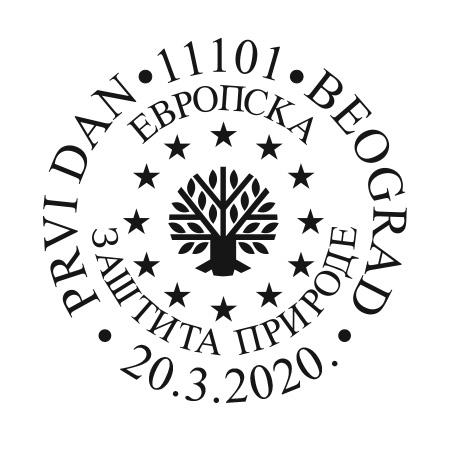
The area of exceptional features ”Tršić – Tronoša Cultural Area”
It is located on the territory of 1802,57 ha. Natural features of the area are comprised of well-preserved complexes of autochthonous oak and other forests, while 83 of 145 plant and animal species are protected, and 62 belong to the category of strictly protected. Coastal area of watercourses is amphibian and reptiles habitat, with 11 protected species. Bird fauna consists of Middle spotted woodpecker (Dendrocopos medius), Red-backed shrike (Lanius collurio) and Ortolan (Emberiza hortulana), which stands out as the species of international significance.
Mammal fauna is comprised of 52 species, and bats fauna is represented by 18 strictly protected species. In 2019, on the basis of the protection study of the Institute for Nature Conservation of Serbia for the ”Tršić – Tronoša Cultural Area”, the Government of the Republic of Serbia adopted a Decree declaring the Area of Exceptional Features ”Tršić – Tronoša Cultural Area” in order to preserve immovable cultural assets, natural values, specific terrain configuration and regional diversity of the landscape character, due to the unique blend of natural and created values.
Dragan Cvijić, Spatial Planning Specialist, The Institute for Nature Conservation of Serbia.
The area of exceptional features ”Vardenik – Strešer”
It is located in the southeastern Serbia, within the region of Vlasina and Krajište, and it consists of Vardenik mountain with its highest peak Veliki Strešer (1876 m). The relief of Vardenik mountain was created in a long time period under the influence of complex geological and geomorphological processes. The flora of the region is characterized by great biological diversity with a total of 414 plant species. This small region is inhabited by 12,3% of Serbian total flora, with 10% of endemic taxons. This area is also characterized by the presence of 54 woody and shrubby species, eight of which are in the ”protected species” status: Turkish hazel (Corylus colurna), Silver birch (Betula pendula), Common juniper (Juniperus communis), Dog rose (Rosa canina), Small-leaved lime (Tilia cordata), Common hawthorn (Crataegus monogyna), Cornelian cherry (Cornus mas) and European bladdernut (Staphylea pinnata). Ichthyofauna of the region has kept a high level of autochthony, and the presence of the Brown trout is significant. This region is internationally important area for plants (IPA), internationally important area for birds (IBA) and a chosen area for butterflies (PBA).
Danko Jović, MSc in Biological Sciences and Ana Petković, Forestry Engineer,The Institute for Nature Conservation of Serbia
Artistic realization of the issue: Miroslav Nikolić.
50th Anniversary of Radio Studio B




Radio Studio B was founded on 1 April, 1970 by a group of journalists from the daily newspaper Borba as the first station outside the state broadcasting system. The broadcast of the programme started at exactly 1 pm. The editorial policy was completely revolutionary at the time – it was an urban radio with a lot of music and a maximum of three minutes of speech between two music tracks. Journalists and presenters brought in a ”traffic light” in the studio and it switched into ”red” every three minutes. No one, not even the most distinguished guests like the Mayor of Belgrade, could speak for more than three minutes at a time.
As early as 1971, the Second Programme on medium wave was launched, which was mainly music programme with news on an hourly basis. Later, the Third Programme was launched, with exclusively classical music, and the production of gramophone records and production of TV commercials were established. Those who will be remembered as the founders are Dragan Marković, journalist for the Borba daily, Slobodan Glumac, director of Borba and Nebojša – Bata Tomaševic, director of the Yugoslav Review.
On March 28, 1990, Studio B tried to broadcast a television programme but the authorities, dissatisfied with its editorial policy, switched off the transmitter. However, the first independent TV station in the Balkans began operating a few months later, in November 1990. The rest is history.
Expert collaboration: Studio B
Graphic realization of the issue: MA Marija Vlahović, academic graphic artist
Sport








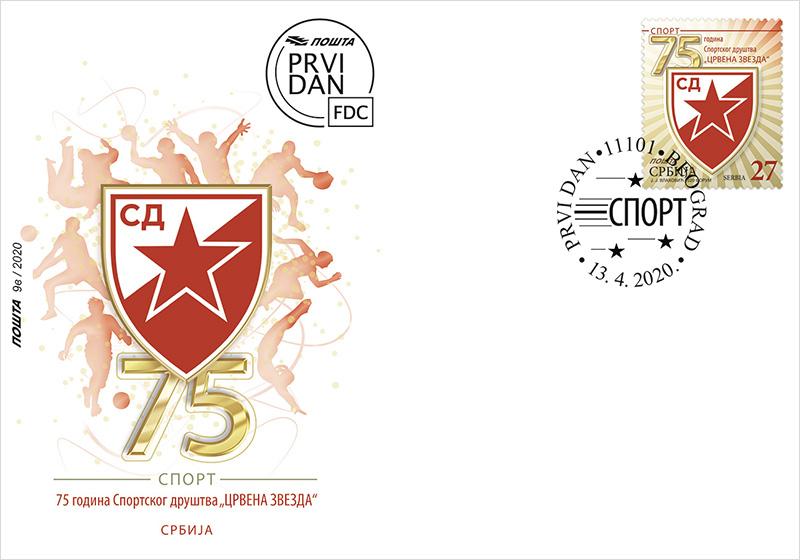

100th anniversary of ”RADNIČKI” Sports Association
”Radnički” Sports Association was founded on 20th April 1920 as the Belgrade Workers’ Sports Club – BRSK. Until the Second World War and during the war, the club had an important revolutionary role.Four of the legendary Seven Secretaries of the Communist Youth of Yugoslavia were its members who got killed at the time of Proclamation (Obznana), and another three before. Ten fighters from the Spanish Civil War came from there as well as 18 national heroes. In the anti-fascist struggle during the Second World War, 117 members of ”Radnički” were killed.
The football club was the hothouse of the sports association, later joined by female Czech handball players; then came the wrestlers, boxers, chess players and important cultural and educational section. Most of the sports association members spent the War in the partisans and the illegal resistance movement.
After the War, ”Radnički” is the first sports association that restored its operation, in November 1944, just after the Liberation of Belgrade. Together with the pre-war clubs, the basketball players also appear, the mountaineers, handball players, rugby players, bowlers, judokas, later karatekas, gymnasts, athletes, shooters, kickboxers. In all these sports, ”Radnički” shows big success. Some of its clubs won 40 team titles of the state champions. Female handball team has been achieving the greatest successes, three times winning the Cup of European Champions and European Cup Winners’ Cup. The sportsmen of ”Radnički” have won 14 Olympic medals, 32 at the world and 42 at the European championships. ”Radnički” was and remains the hothouse from which the most successful coaches and sports workers originated, but also a school of life through which, by nurturing the spirit of the Romantics from the Red Cross Square, many of them completed their studies together with sport, made their doctoral thesis and became university professors.
The ”Radnički” Sports Association was decorated with the Order of Merit for people with silver spokes in 1975, with the Order of Brotherhood and Unity with the silver wreath in 1979, Medal of Nemanja in 2000, and on 15th February 2020 it was decorated with the first-degree Sretenje Order of Merit.
75th anniversary of Yugoslav Sports Association ”PARTIZAN”
The Yugoslav Sports Association ”Partizan” was founded by the victors over fascism – the partizans, in a similar fashion to similar sports models in other countries. At the first post–war All–Army championship, in the summer of 1945, the idea was born that, under the auspices of the Army, a football club was first to be formed. Shortly afterwards, on October 4 of the same year, the Partizan was founded at the present Home of the Army in Belgrade, as the Fysical Education Society of the Central Home of the Yugoslav Army.
Within the Association, football, basketball, athletic, volleyball and chess sections were formed, which, over time, became new clubs by joining the new sports branches. There are 24 clubs today in Partizan family.
There remained a record that the footballers had their first appearance on 6th October, 1945, at the match against the selection of Zemun in which Partizan won 4:2.
In the year 1953, Partisan stops to be related to the Army in organisational aspect and becomes the civil sports association. The results of the Partizan sportsmen continually surcome even the most daring dreams of their founders. Numerous titles of club Europe champions, Olympic medals, world and Europe medals, titles of team and single state champions and Cup winners, all that make YSA ”Partizan” one of the most successful sports associations.
With victorious energy and emotions aimed at achieving the highest sporting goals, generations of Partizans 75 years pass the glory of the founding red-blue, today’s black-and-white colours, as well as Yugoslavia and Serbia, to the pride of all who carry his name in heart.
75th anniversary of ”CRVENA ZVEZDA” Sports Association
The Sports Association ”Crvena zvezda” was founded on 4 March, 1945, and since then eight sections (football, basketball, athletics, volleyball, swimming, rowing, table tennis, chess) have developed into an exceptional sports family of 36 clubs (football, basketball, volleyball, water polo, judo, handball, athletic, tennis, rowing, women’s basketball, shooting, fencing, table tennis, hockey, swimming, chess, women’s water polo, boxing, Crvena zvezda Guiness, kickboxing, karate, cycling, bowling, auto and karting, bridge, tequondo, rugby league, ragbi, weightlifting club, bodybuilding, women’s handball, small football club, skiing, women’s soccer, wrestling and golf). In the true sense of the word, the sports club ”Crvena zvezda” today is one of the most famous sports brands, a respected and recognizable name in the world of sports.Since its founding, ”Crvena zvezda” has been following the cult of a large sports family with charisma and successful results. In the past 75 years, the athletes and clubs of the “Crvena zvezda” SA have been a real example of a good and harmonious organization with the largest number of fans in this part of Europe.
The ”Crvena zvezda” clubs have won 714 trophies since its foundation until January 2020. They were 482 times national champions, 200 times National Cup winners, won 8 European Championships, 12 European Championship titles, 3 World Cups and 9 National Super Cup titles.
The successes we are proud of are the 1991 World Cup and European Champion titles, the European Basketball Champion title in 1979, the Basketball Cup Winners Cup in 1974, the European Waterpolo Championship title in 2013, the European Athletic Champion title in 1989 as well as countless successes and medals of our Jasna Šekarić, Nemanja Majdov, Nenad Stekić, Zoran Manojlović, Dragan Jovanović, Diana Dabetić ...
Expert collaboration: Sports Association ”Radnički”, Yugoslav Sports Association ”Partizan” and Sports Association ”Crvena zvezda”.
Graphic realisation of the issue: MA Jakša Vlahović, Academic Graphic Artist.
International year of plant health



Plants are one of the major elements determining the life existence on Earth. As a source of oxygen, raw material and food for humans, as well as niche for hiding, reproduction and development of many animal species, plants are essential element of both, aquatic and terrestrial ecosystems.
Plant health is under permanent influence of many biotic and abiotic factors, with evident negative trend. Significant negative impact is posed by the natural factors (e.g. plant pathogens and pests, natural disasters), however the plant health is predominantly jeopardized by human influence. Global trade and transport of plants and planting material, including the people travelling worldwide, produced a negative impact on plant health by multiplying the events of global spread and introduction of new plant pests across the globe. Many of newly introduced pests are invasive, colonizing wide areas in short period of time, resulting in severe epidemics with devastating impact on plant health. Furthermore, climate changes significantly influenced the plant health and diversity, via disturbance of natural ecosystems, as well as interference in cropping systems, negatively affecting the food safety and production. It is of particular importance for developing countries and Third World countries which are faced with poverty and hunger.
Plant health protection is a factor of major importance to secure safe future on the planet. In terms of healthy environment and biodiversity preservation, it is of great importance to implement non–invasive ecological methods in plant protection. From the economic and social point of view, plant health control via sustainable agricultural practice will provide necessary food production and contribute to poverty eradication and arising life standard quality, through economy and market development at local and regional scales.
Expert collaboration: Dr Milana Mitrović, Principal Research Fellow, Institute for Plant Protection and Environment.
Artistic realization of the issue: MA Nadežda Skočajić, academic graphic artist
Europa – Ancient Postal Routes
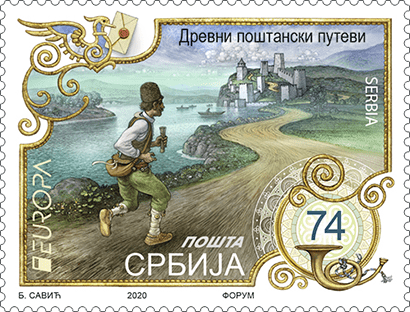





Throughout the history, any strong and well-organised country had a developed network for communications and transport. The Ottoman Empire, within which was Serbia, had a network consisting of tatars (post riders) with a large number of horses, menzulanas (relay stations), inns and caravanserais.
Apart from the tatars, public proclamations and orders were carried from 17th century by pedestrian messengers - sahiyas, especially on shorter distances and in difficult terrains where pedestrians were quicker than horses. Sahiyas were hardy, lean people, armed, dressed appropriately, and wore jingle bells under the left knee as a sign of recognition. The jingling announced their arrival in a populated place, and the bells helped them keep the rhythm while striding
In time, they started to deliver also private letters and small parcels for a fee, and passed the news on recent events, fairs, prices, contagions, and all that was relevant at the time for daily life of the people.
After the Second Serbian Uprising, when it was necessary that the news be passed on foot, quickly, by relay stations and at shorter distances, Prince Miloš used his tatars. The tatars, sahiyas, and later postmen who travelled on coaches used the well-developed and established network of menzulanas over four main road routes (Belgrade-Radujevac, Belgrade-Aleksinac, Belgrade-Mokra Gora and Belgrade-Loznica). This network was organised on the Sava and the Danube, while ferries and boats, and, later, ships, comprised the important link in the swift and safe conveyance of mail.
Expert collaboration: Ljiljana Đorđević, Senior Custodian, PTT Museum, Belgrade.
Artistic realization of the issue: MA Boban Savić, academic painter.
190th Anniversary of Serbian armed forces Guard




Of particular importance for the creation of the modern Serbian state and for the preservation of its independence was the establishment of the Army, which began with the establishment of the Guard, on St. George’s Day 1830, by the decree of the Supreme Prince of Serbia, Miloš Obrenović. In the then-thriving city of Požarevac, that act confirmed the “safeguarding of the right to bear arms”, which was won by the Serbian insurgent uprising against the Turks. That is why the Guard of Miloš, as the first unit of the Serbian Army, symbolically indicates the existence of the Serbian state. Marking the 190th anniversary of its existence this year, today’s Guard is an expression of that continuity, and as a professional military unit, contributes repeatedly to the Serbian Armed Forces as the institution the state trusts the most.
The Guard was a striking military and national symbol at the coronation of King Petar I Karađorđević in 1904, and during World War I his immediate protection and moral role model for the Serbian soldier. Barely recovered, the guardsmen were involved in decisive operations in the breakthrough of the Thessaloniki Front and, with their combat posture, were a role model to every Serbian soldier.
During World War II, part of the Guard officers joined the Yugoslav Army in the Homeland movement, and others joined the National Liberation Partisan Detachments. Then, from the supporting units of the Supreme Headquarters of the National Liberation Army, the JNA Guard was formed, which, over time, having transformed itself in accordance with the requirements and needs of the new state, also had naval units on the Adriatic and Danube since 1948, when it reached its highest number. Sharing the fate of the people and the state, the Guard was restructured and modified, and in November 2006 the former Guard Brigade was transformed into the Guard of the Serbian Armed Forces.
One of the characteristic symbols of the Guard is its representative military orchestra, which has existed since 1831. Today it also represents a kind of a cultural institution, whose recognizable symbol is the magnificent “Drina March”, composed by the head of the Royal Guard Orchestra, Stanislav Binički.
Motif on the cover: Cavalry Officer of the Royal Guard, watercolour by Georges Scott from 1929. (Royal Palace Foundation).
Expert collaboration: Serbian Armed Forces Guard.
Graphic realization of the issue: Nadežda Skočajić, MA graphic artist.
75 years of Victory Over Fascism, 9 May – Victory Day (1945-2020)



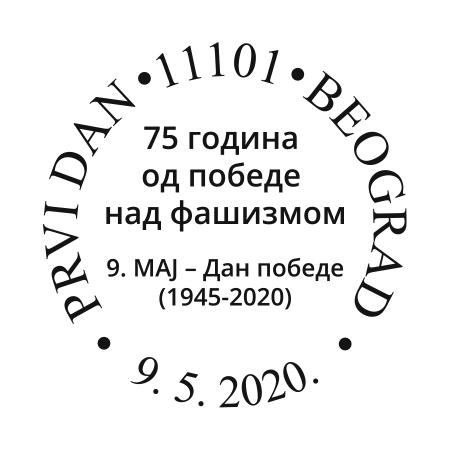
The commemoration of the Day of victory over fascism, May 9, the day of capitulation of Nazi Germany in the World War II is an opportunity to remember the great contribution Serbia gave to the victory over fascism, and the enormous sacrifices which it endured in that fight.
In honor of the victims of the Second World War, since 2007, the manifestation Immortal Regiment has been organized – a parade in which descendants of veterans carry photos of ancestors in gratitude and memory of famous heroes who in the Second World War shed blood to defend their fatherland and became immortal. This manifestation is important for the preservation and spread of the libertarian tradition to the future generations from the Allied countries, once involved in the fight against fascism.
The Immortal Regiment was first organized in the Russian city of Tyumen, as march under the slogan of the Victory Parade. In 2013, it expanded to 120 Russian towns and cities, and one year later, the residents of five hundred towns and cities in seven countries of the world marched the streets with photos of their ancestors, participants in World War II on the side of the anti–Hitler coalition.
Since 2019, the event Immortal Regiment is considered a national event in Serbia that will continue to be celebrated every year on Victory Day – May 9th.
It is the duty of the Government of Serbia and all citizens to teach the future generations the importance of this date and the necessity of nurturing the tradition and remembrance of our heroes in the struggle for the liberation of the fatherland in World War II.
At the initiative of the President of the Republic, Aleksandar Vučić, in hounour of commemoration of the 75th anniversary of the victory in World War II, the PE Post of Serbia issues a commemorative postage stamp and a commemorative First day cover.
Expert collaboration: Ministry of Labour, Employment, Veterans’ and Social Affairs.
Stamp Day

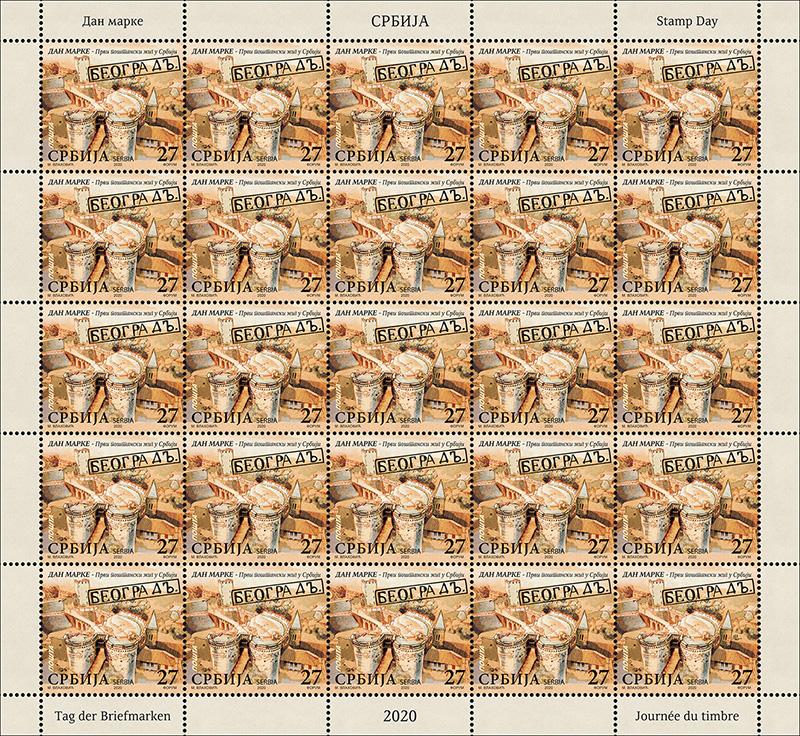


First Postmark in Serbia
The first step towards establishment of the postal service was the ukaz (decree) of Prince Miloš issued in 1835, by which Jakov Jakšić became the supervisor of all the post offices in Serbia, entrusted with the task to organise and establish post offices and to manage them. The postal operations fell within the authority of the Ministry of Internal Affairs. The public postal communications were established in practice without a relevant legal regulation, by using the existing network of menzulanas (relay stations) and couriers.
The regular public postal traffic in Serbia officially commenced when the first post office in Belgrade was opened on 25 May 1840 (by Julian calendar). On that day, the very first postmark in the function of the postal traffic in Serbia was applied on a letter – a flat postmark ”Belgrade” in a rectangular frame, in black, so-called ”framed Belgrade”. This mark was used only on that day, and another postmark, without the rectangular frame, came into use already on 29 May 1840.
On the same day, the Ministry of Internal Affairs notified the Russian, Austrian and French consulates that the postal service was established in Belgrade. The similar news was published in Novine Serbske on 1 June 1840, stating that the letters dispatches to Serbia’s interior were scheduled twice a week: on Wednesdays and Saturdays. It was highlighted that the Post would admit all letters – both official and private. The Post was located at the Kalemegdan fortress, in a building of the governmental menzulana – at a place where the building of the Faculty of Fine Arts is located now, on the opposite side of the today’s Library of the City of Belgrade.
The post offices in Kragujevac, Valjevo, Loznica, Šabac, Požarevac, were opened soon thereafter. Considering that the postmark ”framed Belgrade” was the first postmark used in the postal system of the Principality of Serbia and that it was used only on 25 May 1840, its significance goes beyond the scope of the Serbian philately.
Expert collaboration: Vladimir Milić, MPhil, Graduate Electrical Engineer.
Artistic realisation of the issue: MA Marija Vlahović, academic graphic artist.
Technical details
13. мај 2020.
Уметничка обрада Марија Влаховић
997. 27,00 дин (вишебојна) 25.000
Табак: 25
На коверту са жигом ПД (FDC)
Нацрт: 997. Цртеж Калeмегдана и први поштански жиг у Србији – тзв „уоквирени Београд”.
Величина марке: 35 x 31,9 мм
Tourism in Serbia




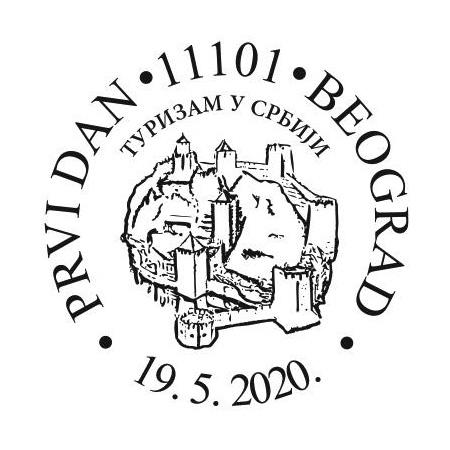
Golubac Fortress
The mediaeval Golubac Fortress is situated on the right bank of the Danube, on a location with exceptional strategic importance: a rocky ridge overlooking and controlling the waterway through the Đerdap Gorge. The first written mention of the Fortress dates back to 1335, when it was held by the Hungarians. As a border fortification, Golubac had a very turbulent history: it changed hands among Serbs, Hungarians and Turks.
To provide more space, the fortress was expanded to the west with additional ramparts and towers with a ditch in front, forming an outer ward. Similar to the older sections of the fortification, the new towers and ramparts were designed for cold-weapon warfare. In the last significant construction phase, at the end of the 15th century when Golubac was in the Turkish hands, the towers and ramparts were reinforced. That provided them with a new either round or polygonal form.These reinforcements were built to make the towers more resistant to cannons and firearms. At the same time, a low polygonal tower was built projecting to the Danube where the cannons were mounted on two storeys, making the Fortress more adapted to the new warfare techniques.
A settlement was formed west of the fortification, where, according to old pictures, a church was built as well. At the time of the Turkish rule, a mosque and a hammam were built in the settlement’s outlying district.
Expert collaboration: Institute for the Protection of Cultural Monuments of Serbia – Belgrade;
Tourist Organisation Golubac.
Graphic design of the issue: MA Anamari Banjac, Academic Painter
Science



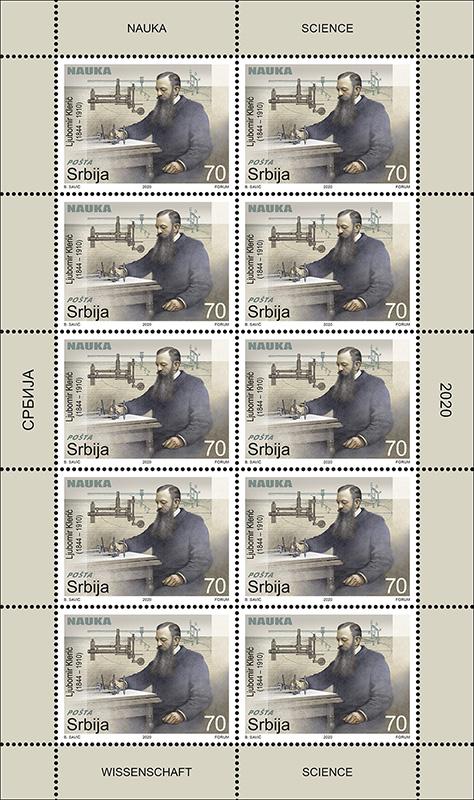



The Belgrade Hand
The first intensive research in the field of robotics in Serbia began in the 1960’s at the Mihajlo Pupin Institute, where the so-called Belgrade School of Robotics was established.Professors at the Faculty of Electrical Engineering in Belgrade Rajko Tomović and Miodrag Rakić, began pioneering work on making an artificial hand in 1963. In the same year, at the Mihajlo Pupin Institute they constructed a model of the world’s first prosthetic robotic hand with an external power supply. The hand had five fingers, microelectronic control and sensory feedback. It made it possible to grasp objects with bent and outstretched fingers. This model of the multifunctional external hand prosthesis is known in the world as the Belgrade Hand
It was the first human-like self-adaptive artificial hand with four fingers and the thumb in the size of a human hand. The finger-tips were equipped with pressure sensors, an the hand interfaced the forearm by the wrist which allowed hand pronation and supination. The control method was designed based on heuristics gained by trying to mimic the human grasping. The control implemented the principle of adaptation of the grasp pattern which maximized the contact area between the object and the hand. The self-adaptation was made possible by the intelligent mechanics that used only on a single electrical actuator to control all fingers and the thumb. After the user initiated volitionally the grasp the actuator started flexing the fingers and the thumb.When the fingertips contacted the targeted object, the actuator continued with flexing all fingers and the thumb until the pressure was equalized among them. This made the hand shape adaptive without any voluntary effort of the user. The self-adaptation allowed the palmar, lateral and precision grasps.
Although it was not used as an orthopaedic aid, the Belgrade Hand is significant because in the follow-up research it influenced the development of robotic arms in the world. By developing new versions, a team of engineers from the Institute worked on improving its adaptability. The work on the robotic hand intensified the activities in the field of robotics at the Mihajlo Pupin Institute, so in 1967 the Robotics Laboratory was founded as the first one in the South-eastern Europe.
Expert collaboration: Ivan Stanić, curator of the Museum of Science and Technology, Belgrade and Аcademician Prof. Dr Dejan Popović, Serbian Academy оf Sciences аnd Arts
Artistic realization of the issue: Boban Savić MA, academic painter
Ljubomir Klerić (1844 – 1910)
Ljubomir Klerić (born Julius Clery, Subotica 29 June 1844 – Belgrade 21 January 1910), was a mining engineer, geologist, scientist, constructor, inventor, founder of the Serbian school of mechanical engineering and mechanics, university professor, a member of the Serbian Learned Society, the Serbian Royal Academy (today Serbian Academy of Science and Arts), Hungarian Academy of Science, proposed Nikola Tesla to become a corresponding member of the Serbian Royal Academy, participated in the Serbian – Turkish wars, was the minister of education and the minister of economy, a state counsellor, a dean of the Faculty of Technics at the Great School in Belgrade, a member of the Commission for forming the University of Belgrade, etc.
He finished primary school in Subotica and graduated from the gymnasium in Belgrade. After the second year at the Great School, he was sent to the Mining Academy in Freiberg. During his studies, he spent one term in Zurich Polytechnic School to study mechanical engineering. He continued studying specialist courses at the Mining Academy in Berlin.
As a mining engineer of a comprehensive top education, Mr. Klerić belongs to the people who open, guide and create new directions in the field of engineering. His scientific and professional work in mining, geology, mechanical engineering, mathematics, mechanics, telemetry and analogous computing can confirm that
He was exploring the deposits of mercury and opened a mine on Avala, and surveyed the conditions of the mines on Venčac, Rudnik and Kosmaj, and during the railroad building on the route Ćuprija – Aleksinac, he did the geological explorations and also explored the deposits of iron near Oran in Africa. On behalf of Serbian Government, in Budapest he was in charge of the control over the project and testing of the stone quality for the construction of the Sava Bridge, etc.
He is a constructor of a soil drill machine, mining cartridges, underwater mines, tractography, telemeter, polar pantograph, and the device for drawing the second-line curves. At the Great School he was elected a full-time professor for subject Mechanics and Science of Machines, and when this subject was divided in two courses, he took over the subject Theoretical Mechanics. He founded two Departments of the Great School: Department for Descriptive Geometry with Projective Geometry and Graphics-Statics and the Department on the dry and water construction.
He was the author of numerous scientific papers and discussion, coursebook Theoretical Mechanics (three books, 1317 pages) and two monographies: Current Results in Kinematics and Tractoriograph.For his war merits he was decorated with the Medal for Courage and Takovo Cross. He was also decorated with the Belgian King Leopold II Medal.
Expert collaboration: Ivan Stanić, curator of the Museum of Science and Technology, Belgrade and Аcademician Prof. Dr Dejan Popović, Serbian
Artistic realization of the issue: Boban Savić, MA, academic painter.
70 Years since Foundation of the Faculty of Transport and Traffic Engineering at University of Belgrade




Faculty of Transport and Traffic Engineering – University of Belgrade is the oldest and most important institution of higher education in the field of transport and traffic engineering in Southeast Europe. Its history began by founding of the Higher School of Transport and Traffic on 8 September 1950, exactly 142 years after the foundation of the Higher School, the forerunner of today’s University of Belgrade. After several reorganizations of higher education in the area of technical sciences, applying the new Law on universities adopted on 8 June 1960, the Faculty of Transport and Traffic Engineering was founded. Only a year later the Institute for Studuying and Improvement of Traffic and Transport began working, the forerunner of the Institute of Transport and Traffic Engineering. In 1978–79 school year the Faculty of Transport and Traffic Engineering moved into a new building, the architectural solution presented with the October Award of the City of Belgrade. In the heart of one of the most beautiful Belgrade municipalities, at the famous adress 305 Vojvode Stepe Str, on 13,750 m2, there still stands the seat of science and education in the field of traffic, transport, logistics and communications.
In its 70 years of existence, Faculty of Transport and Traffic Engineering educated more than 9500 BSc and MSc in transport and traffic engineering, and around 200 PhDs in technical sciences. Today, at nine moduls of basic studies, 11 moduls of master studies as well as PhD studies, 2000 students acquire scientific and professional knowledge in the area of road, railway, water, air, postal, telecommunications traffic and logistics.
Besides modern study programmes, Faculty of Transport and Traffic Engineering is also characterized by prominent results in scientific and research work and intensive cooperation with economy and leading domestic and international institutions in the field of traffic and transport. Faculty of Transport and Traffic Engineering has realized over 2000 projects, expertises and studies, including participating in 17 large European research projects.
With 70 years long tradition Faculty of Transport and Traffic Engineering, through sinergy of science and higher education, continues to build a world where space and time are easily managed.
Expert collaboration: prof. Dr. Nebojsa Bojović, Dean of the Faculty of Transportation.
Artistic realization of the issue: Anamari Banjac, academic painter.
Great Serbian Chess Grandmasters



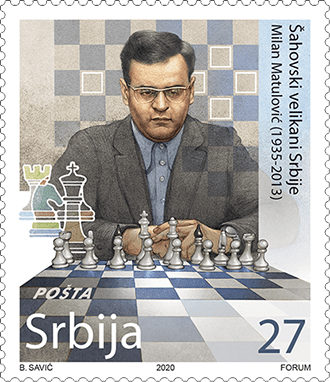


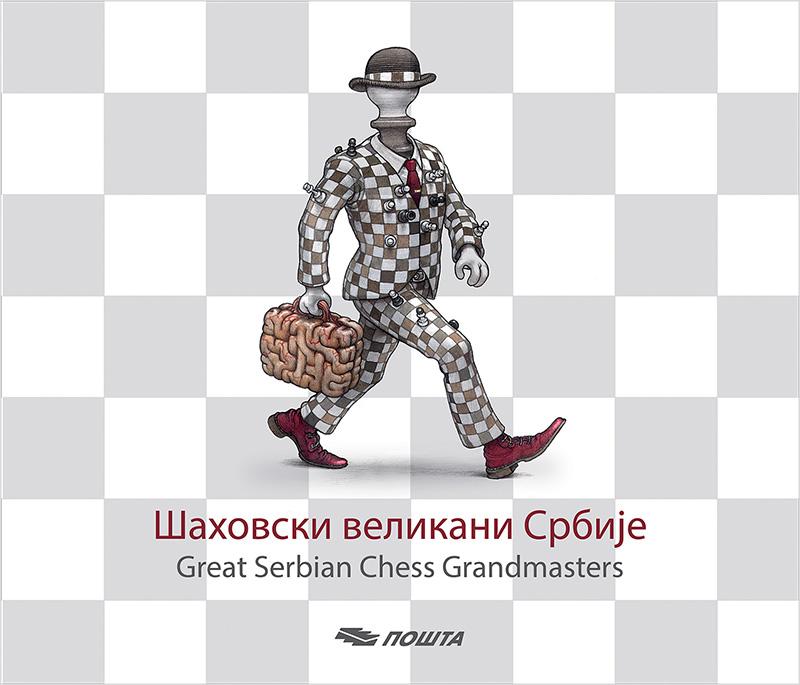




Bora Kostić (Vršac, 1887 – Belgrade, 1963)
The first Serbian chess grandmaster, chess bohemian and romantic, globetrotter and polyglot, who was described by the famous Capablanca as ”an uncut chess diamond”. Day after day, year after year, his life was chess and travel. He played in 70 tournaments in the most successful period and was among the top ten chess players in the world. At the 1st Chess Olympiad in London in 1927, he played on the first board for our team. When he won a game he was in good spirits. He lit a cigarette, even though he was a non-smoker; he spoke and the audience listened to him unblinkingly. He was a guest at the courts of kings and maharajas, a lecturer in Argentina and Mexico. He taught the great Caruso to play chess; attended Lenin’s funeral in Moscow. He was received by Kemal Ataturk, played chess with Trotsky, but also with the chief of the Bataka tribe in Sumatra. He played a famous game in which the chessboard was on the equator, and the opponents were sitting in the northern and southern hemispheres! He was in Lhasa in Tibet when white people were a rarity there. He refused to respond to the mobilization of the Austro-Hungarian army in 1914 ”because he is a Serb”. He was arrested during the Second World War, due to his refusal to play in tournaments because Serbia was under occupation. His contribution to chess and the Serbs is written in golden letters. Chess and chess - players of Serbia followed in his footsteps, and in his native Vršac he received a monu ment and a street from grateful fellow citizens.
Кад добије партију добре је воље. Запали цигарету, иако је непушач; говори а публика га нетремице слуша. Био је гост на дворовима краљева и махараџа, предавач у Аргентини и Мексику. Шаху је учио великог Каруза; био је у Москви за време Лењинове сахране. Примио га је Кемал Ататурк, играо је шах са Троцким, али и са поглавицом племена Батака на Суматри. Одиграо је чувену партију у којој је шаховска табла била на полутару, а противници су седели на северној и јужној полулопти! У Ласи на Тибету је био када су бели људи тамо били реткост. Одбио је да се одазове мобилизацији у Аусто-Угарску војску 1914. „јер је Србин”. За време Другог светског рата ухапшен је, јер је одбио да игра на турнирима због тога што је Србија под окупацијом.
Златним словима исписан је његов допринос шаху и српству. Његовим трагом кренули су шах и шахисти Србије, а у родном Вршцу добио је, од захвалних суграђана, споменик и улицу.
Petar Trifunović, PhD (Dubrovnik, 1910 – Belgrade, 1980)
Chess grandmaster and Doctor of Laws, he became familiar with chess late, only at the age of 16. Nevertheless, it did not get in his way of becoming the champion of Yugoslavia five times, a member of the Olympic team seven times, successful in important tournaments: Prague (1946), Lima (1950), Belgrade (1954), Natania (1961), Noordwijk (1965) ... He was close to participating in the Tournament of Candidates for the World Championship in 1950. He played differently from his long-time close friend Bora Kostić – he was a long-distance player, with small steps and positional play, looking for small advantages, without major risks and obligations, without rushing to checkmate. He was a well-known chess pedagogue and coach, President of the Chess Federation of Serbia, captain of the Yugoslav national team at the 1960 Olympiad in Leipzig. Along with Bora Kostić and Svetozar Gligorić, he laid the foundations of our decadeslong chess success.
Био је на домаку учешћа на Турниру кандидата за првака света 1950. године. Играо је другачије од свог дугогодишњег блиског пријатеља Боре Костића – на дуге стазе, ситним везом, позиционом игром, тражећи мале предности, без већих ризика и обавеза, не журећи да дâ мат. Био је познати шаховски педагог и тренер, председник Шаховског савеза Србије, капитен репрезентације Југославије на Олимпијади у Лајпцигу 1960. године.
Уз Бору Костића и Светозара Глигорића поставио је темеље нашег вишедеценијског шаховског успеха.
Svetozar Gligorić (Belgrade, 1923 – Belgrade, 2012)
Our best chess player and one of the best in chess history. He saw chess for the first time at the age of 8 and played the last tournament at the age of 79. He won 65 tournaments, won 12 Olympic medals and six medals at the European team championships. He was the champion of Yugoslavia 11 times and he led the national team of Yugoslavia and Serbia for almost 30 years. He is the winner of the AVNOJ award, the Order of Nemanja and the Order of Vuk Karadzić. The best high school students in Belgrade, including Gligorić, were invited to celebrate the 14th birthday of the heir to the throne Peter II Karadjordjević in 1937. Gligorić spent his childhood and youth in difficult conditions because as a child he lost his father, and at the age of 17 he lost his mother, but since then, with white or black pieces, whoever he played against – he would win. Gligorić is also known for his successful journalistic career. He spoke several languages. He was a regular correspondent for Chess Review and Chess Life magazines and the author of numerous books on chess.In the last decade of his life, he returned to his love from his youth – music. He learned to play the piano, and after seven years he published his compositions. He was buried at the New Cemetery in Belgrade in the Alley of the Greats. He did not actually leave – as long as chess and chess players live, he will live with them.
У последњој деценији свог живота, вратио се својој љубави из младости – музици. Учи да свира на клавиру, и после седам година објављује своје композиције. Сахрањен је на Новом гробљу у Београду у Алеји великана. Није отишао – док је шаха и шахиста, живеће са њима.
Milan Matulović (Belgrade, 1935 – Belgrade, 2013)
A national master since 1955, an international master since 1961 and a grandmaster since 1965, he learned the secrets of the ancient game at the age of 13, and began to achieve more notable results at the age of 16. He won two team silver Olympic medals in Tel Aviv in 1964 and Lugano in 1968, two bronze medals, in Siegen in 1970 and in Skopje in 1972. He had the best single result at the Olympiad in Tel Aviv, together with Smyslov. He won 60 points from 78 games at five Chess Olympiads, so he is the most successful Yugoslav Olympian of all time. He was the champion of Yugoslavia in 1965 and 1967, and he also participated in 6 zonal and two interzonal tournaments for the World Championship. He won silver medals at the European Team Championships in Oberhausen in 1961, Hamburg in 1965 and Batu in 1973. He played for the world - selection against the USSR at the Match of the Century in Belgrade in 1970. He tri umphed in 32 international tournaments, and achieved a grandmaster result 25 times. He defeated the greats of his time: Fischer, Tal, Karpov, Smyslov, Spassky, Korchnoi, Bronstein, Timman, Reshevsky, Larsen, Portisch, Polugaevsky...
Milunka Lazarević (Šantrovac, near Jagodina, 1932 – Belgrade, 2018)
One of the best women world chess players of her time, a grandmaster, interna tional chess arbiter, and journalist. From 1953–1982 she was the champion of Yugoslavia 11 times. She won a silver medal at the Olympiad in Split in 1963. She continuously participated in the competition system for the world championship for 25 years. She is the only Yugoslav women chess player to have played twice in matches of candidates for the world championship. At the Candidate Tournament in Sukhumi in 1964, the American Gisela Gresser offered her a draw before the game, which would place her in the title match. Driven by the attitude that chess is a chivalrous game, not a trade – she refused the offer and lost the game. With - this unique gesture in the history of the ancient game, she gained a huge reputa tion in the chess world. At that time, she was third on the world ranking list, and for years the best chess player in the world outside the USSR. She was the first Yugoslav female chess player, and the second female player in the world to be recognized as a grandmaster.As President of FIDE Women’s Chess Commission from 1970 until 1978 she was the initiator or organizer of numerous competitions, and she also introduced a number of revolutionary novelties: she united the men’s and women’s Olympiad: proposed the introduction of the title of female grandmaster, which was accepted; initiated the Women’s Youth World Championship and the Women’s European Champions Cup; she introduced matches instead of candidate tournaments for women… As a journalist, she wrote for many domestic and foreign magazines. She conducted interviews with all the chess greats of her time, but also with numerous personalities from the world of culture: Lorin Maazel, Maya Plisetskaya, Natalya Besmertnaya, David Ojsztrah, Igor Markevitch, Otomar Krejcha, Aram Khachaturian, Peter Ustinov.She was awarded the Sretenje Order of the third degree, and she was also an honorary member of FIDE. She was buried in the Alley of Deserving Citizens at the New Cemetery in Belgrade.
Expert collaboration: Aleksandar Matanović, Grandmaster, Miroslav Nešić, sports journalist, Borivoje Žarić, international chess arbiter, Prof. Dragoslav Đukanović and Serbian Chess Federation.
Artistic realization of the issue: Boban Savić, MA, academic painter.
Joy of Europe




“Joy of Europe”, the largest and the oldest international manifestation of children’s creativity, was established back in 1969, on the occasion of the World Children’s Day. Since 1998, the International Visual Arts Competition “Joy of Europe” is included in the manifestation and, ever since its foundation, it outgrew the limits of the European continent and united children and the youth from all over the world. This competition brought to the Children’s Cultural Centre Belgrade a rich treasury of artworks that carry within themselves immense artistic values from diverse cultural backgrounds.
Because of the global pandemic, the Children’s Cultural Centre decided to cancel the scheduled programme related to the International Visual Arts Competition “Joy of Europe”. As the visual art meeting and support to natural and creative way of life have been the essence of the international competition for more than twenty years now, it is decided that this year the visual meeting would take a virtual form, and the 23rd International Visual Arts Competition “Joy of Europe” will have the character of a non-competitive show. The visual art schools and ateliers that have been represented in the visual art meetings “Joy of Europe” for more than ten years are cordially invited to display the recent works of their young artists.
This year, the selection of artworks for postal stamp, vignette and envelope is characterised by global pandemics, and the message is clear. The fear of unknown, isolation and tension affect the children and the youth around the world in many ways. In this time of isolation, the communication is most important of all. More than ever before, young people have the opportunity to introspect, to learn to communicate with their inner selves, to discover their talents, practice art, find the beauty of literature, film, painting, music… The beauty will save the world, said the great Dostoevsky, whose message tells us that we can make this dark period surprisingly useful if only we discover the beauty of the art.
Motif on the stamp: drawing by Tanja Novaković (15 years, Serbia). The authors of drawings on vignettes are: Preslava Staneva (13 years, Bulgaria), Munjapara Vraj Adarshbhai (7 years, India), Guo Ziwei (14 years, China), Nataša Vlahović (7 years, Serbia), Selen Naimova (13 years, Bulgaria), Sara Matić (13 years, Serbia), Raima Amandbhai Maniyar (13 years, India). Motif on the envelope: drawing by Tsz Yan Katlyn Lai (8 years, China).
Expert collaboration: Lidija Seničar, Editor of drawing and painting competition, Children’s cultural centre Belgrade.
Graphic realisation of the issue: MA Jakša Vlahović, Academic Graphic Artist.
Christmas






Christmas is one of the most important and one of the most joyous Christian holidays, that is celebrated both by the Orthodox and Catholic believers. The difference is only in the date of the celebration; the Orthodox celebrate it on January 7th, and the Catholic on December 25th, but its message remains the same – the message of peace and love.
We celebrate Christmas for three days. It is primarily family holiday, and there are numerous traditions and customs regarding Christmas. On the day before Christmas and Christmas Eve, the yule log is being brought into house, cresset lit and hay with hidden candies, prunes, walnuts, sugar and coins, spread all over the house. The hay is a symbol of the manger in which Christ was born. The yule log represents longevity and substance of Christianity, as well as of the warmth of the love Christ brought to us when he was born and arrived to the Earth. On the very day of the Christmas, early in the morning the church bells of all Orthodox temples are ringing, announcing the nativity of Christ.
People go to church to attend Christmas liturgy and they all greet each other by “Christ has been born” and “Indeed he has”.
Expert collaboration: The Museum of the Serbian Orthodox Church in Belgrade.
Artistic realisation of the issue: MA Marija Vlahović, academic graphic artist.
65 years since the opening of the Nikola Tesla Museum in Belgrade












The Nikola Tesla Museum in Belgrade is a unique institution of science and culture in the world. It is entirely dedicated to the genius inventor, scientist and engineer, Nikola Tesla (1856–1943), who gave humanity an enormous amount of significant discoveries and inventions.
His inventions in the fields of electrical engineering, mechanical engineering, radio engineering and wireless control, the ingenuity of his solutions, the universality of application and the shifting of many scientific and technological boundaries have changed the image of the world around us. With the efforts of Tesla’s nephew, Sava Kosanović, in 1951 all personal objects and writings of Nikola Tesla were transferred to Belgrade. In June 1952, Tesla’s legacy was transferred to “Genčić’s Villa” situated in, as it was known then, Proleterskih brigada Street no. 51 (today Krunska Street). On the proposal of the Council for Science and Culture, the Government of the Federal People’s Republic of Yugoslavia passed a Decision on the establishment of the Nikola Tesla Museum on December 5, 1952. The museum was opened to the public on October 20, 1955, and was the first technical museum in the former Yugoslavia. On that occasion, a permanent exhibition was presented where visitors could observe models made according to Tesla’s designs.
The permanent exhibition of the Museum, which has been located at the same address since its founding, displays numerous photographs and documents, personal items of Nikola Tesla, laboratory instruments and interactive models of his inventions, faithfully depicting the most important details of Tesla’s life and his epochal discoveries. The legacy of Nikola Tesla is preserved, processed and studied within the three basic collections of the Museum: the Archive, the Collective Fund and the Library.Stamp motifs: induction motor – cross section; induction motor with egg-shaped rotor; Tesla’s remote controlled ship with a logic (i) circuit; induction motor with a disk-shaped rotor (exhibits from the permanent exhibition of the Museum). Vignette motifs: patent drawing – remote controlled ship (Nikola Tesla’s personal fund); bust of Nikola Tesla, work by Ivan Meštrović (permanent exhibition of the Museum); Tesla’s notes on hotel paper – November 1888 (personal fund of Nikola Tesla); the building of the Nikola Tesla Museum at Krunska Street no. 51 in Belgrade. Motif on the envelope: photo of Nikola Tesla (Nikola Tesla’s personal fund).
Expert collaboration: Nikola Tesla Museum.
Artistic realization of the issue: MA Nadežda Skočajić, academic graphic artist
75th Anniversary of the UN




The marking of the 75th anniversary of the United Nations is an opportunity for us to confirm once again our collective commitment to multilateralism and the principles to which all the UN Member States pledged allegiance by signing the Charter of the United Nations. It is with pride that we point out that Yugoslavia actively participated in the establishment of the United Nations and was among the first fifty signatory States of the Charter of the United Nations.
The Republic of Serbia remains firmly committed to the goals and principles of the Charter of the United Nations and the promotion of international relations based on the respect of international law and human rights and the creation of conditions for accelerated economic prosperity and sustainable development all over the world. The sovereign equality of States, renunciation of the use of force, non-interference in the internal affairs of States, respect for the sovereignty and territorial integrity, peaceful settlement of disputes, as well as restraint from taking unilateral measures and actions that are not in accordance with international law are key preconditions for the maintenance of international peace and security as provided for by the Charter of the United Nations.
We believe that the United Nations is just as necessary today as it was at the time of its inception and that, in the circumstances in which we face new challenges, the principles woven into the Charter of the United Nations are vested with added values. History teaches us that we should not wait and provoke horrors of global proportions, like World Wars I and II, in order to create a more perfect system and limit arbitrary decisions. It is the responsibility of each and every United Nations Member State to be committed to the achievement of the goals of the United Nations and base its activity on the principles on which the United Nations is founded.
Expert collaboration: Ministry of Foreign Affairs of the Republic of Serbia.
Artistic realization of the issue: MA Jakša Vlahović, academic graphic artist.
125 Years of the Natural History Museum in Belgrade

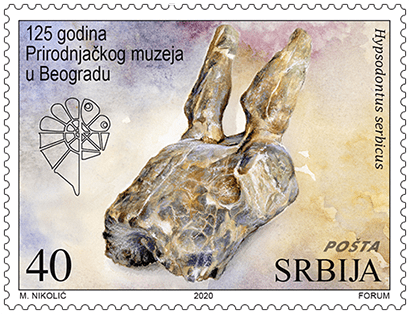

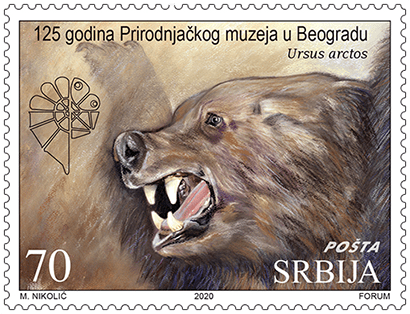


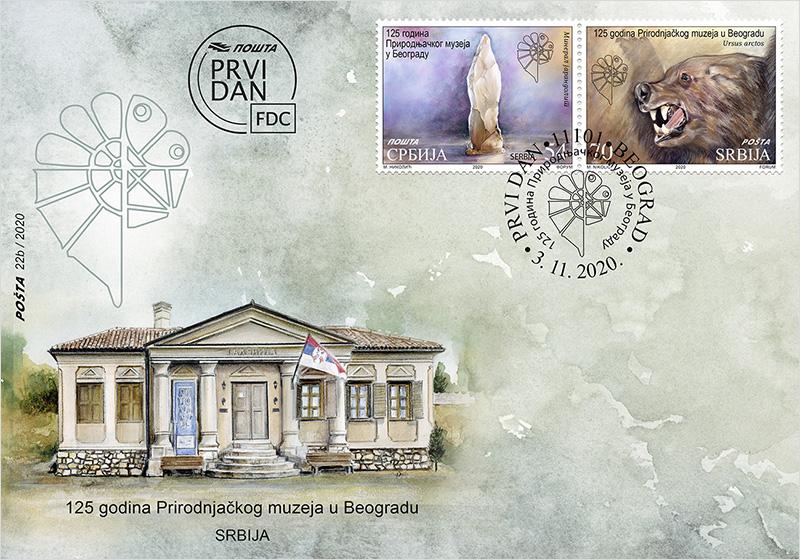

The Natural History Museum was founded on 19 December, 1895 and is one of the oldest scientific and cultural institutions in Serbia. The museum is also the first specialized institution whose three main and inseparable activities are scientific study, protection and presentation of national natural heritage.
In the largest biological and geological collections in our country, there are more than two million valuable specimens and a lot of unique HOLOTYPES – standards by which newly discovered species were described for the first time. The collections of the Natural History Museum contain objects in the 4.5 billion year time span, ranging from meteorites from the time of formation of the solar system, hundreds of millions of years old fossils, to specimens of Serbian spruce and Ramonda serbica. The museum is the only one of its kind in Serbia.
Rtanjska metvica (Nepeta rtanjensis)
On the basis of the specimens found by Bojana Milojević in 1974, this species was determined as a new one for science by Nikola Diklić, the curator of the Natural History Museum. This discovery is exceptional, the plant is endemic and of a relict character, it grows only on the mountain Rtanj. The first specimens on the basis of which it is described are kept in the Natural History Museum.
Extinct crooked horned antelope (Hypsodontus serbicus)
During a 1969 excavation in Prebreza, experts from the Natural History Museum found a fossilized skull of a hitherto unknown species of extinct antelope. The finding is extremely significant, this new species was found for the first time on the territory of Serbia. The specimens on the basis of which it is described are kept in the Natural History Museum.
Jarandolite mineral
The mineral was found by geologist Dobrica Stojanović in the vicinity of Baljevac on the Ibar and described in 1992. He donated a few samples to the Natural History Museum. He suggested the name srbijanit, which was not accepted. A Russian team which did some research in the same area proposed the name jarandolite for the newly discovered mineral, which was officially adopted in 2004. It belongs to the group of rare boron minerals
The last bear of Jastrebac mountain (Ursus arctos)
It was shot in 1885 by King Milan I Obrenović. The taxidermy preparation was made by the Viennese imperial preparator Eduard Hodek. It was placed in the hall of the Old Palace of the dynasty and was silent witness of the May Coup. It has been preserved thanks to Queen Natalija and was exhibited in the Museum of Forestry and Hunting. Today it is kept in the Natural History Museum. It represents a cultural heritage of exceptional importance.
Expert collaboration: Boris Ivančević, PhD, Milan Paunović, PhD, Marjan Niketić, PhD, Sanja Alaburić, Aleksandar Luković, Natural History Museum in Belgrade
Artistic realization of the issue: Miroslav Nikolić
100th Anniversary of the Intellectual Property Office








The Intellectual Property Office celebrates this year 100 years of its existence. By the decree of the heir to the throne Alexander I Karađorđević on November 15, 1920, the Administration for the Protection of Industrial Property was established as the first government body whose basic competence was to deal with the protection of patents, trademarks and industrial designs. In November 1920, Janko Šuman, Ph.D of Laws, born in Maribor on December 20, 1867, was appointed the first President of the Administration for the Protection of Industrial Property. While at the head of the Administration, Dr. Šuman laid the foundations for the protection of intellectual property in the then Kingdom of Serbs, Croats and Slovenes. Janko Šuman is the creator of our first Law on Unfair Competition from 1930 and one of the authors of our first Copyright Law from 1929. He stayed at that duty until retirement on October 28, 1937. Among the temporary members of the Аdministration, we find one of the greatest Serbian scientists of all times, Milutin Milanković, full time professor at the University of Belgrade.
The Office actively cooperates with all the state institutions dealing with intellectual property in the Republic of Serbia, and with his work he contributes the economic development of our country. The Office also elaborates legislation in the field of intellectual property, conducts activities of training for the economy and the academic world, represents our country in the most important international institutions such as the World Intellectual Property Organization (WIPO) and the European Patent Organization (EPO).
Motifs on stamps:
- The building in Krunska Street 14, the first seat of the Administration for the Protection of Industrial Property, from November 1921 to April 1929 and a portrait of Dr. Janko Schuman, the first president of the Administration.
- Тhe first ever patent registered in Serbia in 1921: Device of the Cauldron for the Production of Brandy, made by the inventor Milan T. Jovanović, producer of cauldrons from Novi Sad.
- Pirot carpets: Rasic's pattern, Doves on the pole, Covers, Bombs and Wreaths.
- Current building of the Intellectual Property Office – situated in Kneginje Ljubice Street 5 (ex Zmaj Jovina 15) in Belgrade.
Expert collaboration: Biljana Jovičić, Intellectual Property Office, Head of the Registry Department.
Artistic realisation of the issue: MA Marija Vlahović, academic graphic artist.
950 Years since the Founding of the Monastery of St. Prohor of Pčinja




The Monastery of St. Prohor of Pčinja was founded by the Byzantine emperor Romanos IV Diogenes 950 years ago – in 1070, as a sign of gratitude to Saint Prohor who predicted that he would become the emperor, and the great restoration of the monastery was performed by King Milutin in 1320.Since then, until today, in the greatest shrine in the southeastern Balkans, the myrrh has been streaming from the relics of Saint Prohor of Pčinja.
During the centuries long slavery under the Turks, the monastery persevered and was the centre of literacy of the Serbian people as a spiritual and cultural centre of preservation of religious, national and cultural identity.In the first half of the 19th century, the monastery was the bearer of the liberation struggle from the Turks, so in 1843 it was burned down.In the second half of the 19th century, lodgings were built in the monastery – the pearls of folk architecture of the southeastern Balkans: Vranjski konak, Severni konak and the Metropolitanate.
On the eve of the Berlin Congress in 1878, a large National Assembly of representatives of the Serbian people from the area of Old Serbia – the southeastern Balkans was held in the monastery, urging Prince Milan Obrenović to “by no means let them remain as part of Turkey, but to join them to the Principality of Serbia…”
With the contribution of King Aleksandar Obrenović in 1899, a new church was built in the monastery, and the monastery got its present appearance in 1913, with the construction of the King's residence, built by King Petar I Karadjordjević the Liberator, as a sign of gratitude to the monastery for its contribution to the liberation of the Serbian people from Turkish slavery.
The monastery was destroyed in the First World War, when the Bulgarian occupiers killed the abbot of the monastery Vladimir (Protić) with the fraternity in 1915, and it also suffered in the Second World War from the same occupiers.During 2020, the monastery marks 950 years of the founding and 700 years of the great restoration.
Motifs: on the stamp – The Monastery of the Saint Prohor Pčinjski; on the vignette – Saint Prohor Pčinjski (fresco, 14th century); on the FDC – Saint Prohor Pčinjski (fresco, 14th century) and monastery with its surroundings.
Expert collaboration: Eparchy of Vranje of the Serbian Orthodox Church.
Graphic realization of the issue: MA Nadežda Skočajić, graphic designer.
Patron Saint’s Day – Feast of the Annunciation




Patron saint’s day (slava, baptismal name) represents an Orthodox rite dedicated to a chosen Christian saint to whom a family prays as their patron, protector and blessing giver. Patron saint’s day is a unique and vital element of intangible cultural heritage of the Serbian people and the Serbian Orthodox Church and, as a result, it was inscribed in UNESCO Intangible Cultural Heritage List in 2014.
It is celebrated on March 25 according to the Julian calendar i.e. on April 7 according to the Gregorian calendar, the Annunciation Day celebrates the appearance of the Archangel Gabriel to the Virgin Mary with the good news that the Son of God will be born. This happened in Nazareth, in the house of the righteous Joseph.
The Holy Apostle Luke in his Gospel (chapter I, verses 26-38) writes the following about this event:
And having come in, the angel said unto her, “Rejoice, favored one! The Lord is with you. Blessed are you among women!”
But when she saw him, she was troubled at his saying, and considered what manner ofgreeting this was.
Then the angel said to her, “Do not be afraid, Mary, for you have found favor with God.
And behold, you will conceive in your womb and bring forth a Son, and shall call His name Jesus.
He will be great, and will be called the Son of the Highest; and the Lord God will give Him the throne of His father David.
And He will reign over the house of Jacob forever, and of His kingdom there will be no end.”
Then Mary said to the angel, “How can this be, since I do not know a man?”
And the angel answered and said to her, “The Holy Spirit will come upon you, and the power of the Highest will overshadow you; therefore, also, that Holy One who is to be born will be called the Son of God.
(...) Then Mary said, “Behold the maidservant of the Lord! Let it be to me according to your word.”
And the angel departed from her.
Feast of the Annunciation is one of the feasts of the Mother of God. It is always celebrated during the Great Lent. It is a so-called “Moveable Fest”, which means that except for March 25, i.e. April 7, it may fall on another day between the Thursday of the third week and the Wednesday of the Holy Week of Great Lent.
The earliest testimony of the Annunciation Day celebration can be found in the 7th century, but sermons from the 4th century have been preserved, so it can be assumed that the holiday was celebrated earlier.
Troparion: Annunciation, tone 4:
Today is the beginning of our salvation, / the revelation of the eternal mystery! / The Son of God becomes the Son of the Virgin / as Gabriel announces the coming of Grace. / Together with him let us cry to the Theotokos: / Hail, O Full of Grace, / the Lord is with You!
Мотив на марки: Благовести (икона, 44,2 × 27,5 × 3,2 cm, рад Зографа Лонгина, око 1570. темпера на дасци, позлата, ризница манастира Високи Дечани).
Мотив на коверту: икона Благовести из манастира Високи Дечани; кандило, шаралица и славски колач, Етнографски музеј у Београду.
Expert collaboration: Miljana Matić, PhD; curator of the Serbian Orthodox Church Museum in Belgrade.
Graphic processing: Anamari Banjac, academic painter.
Art





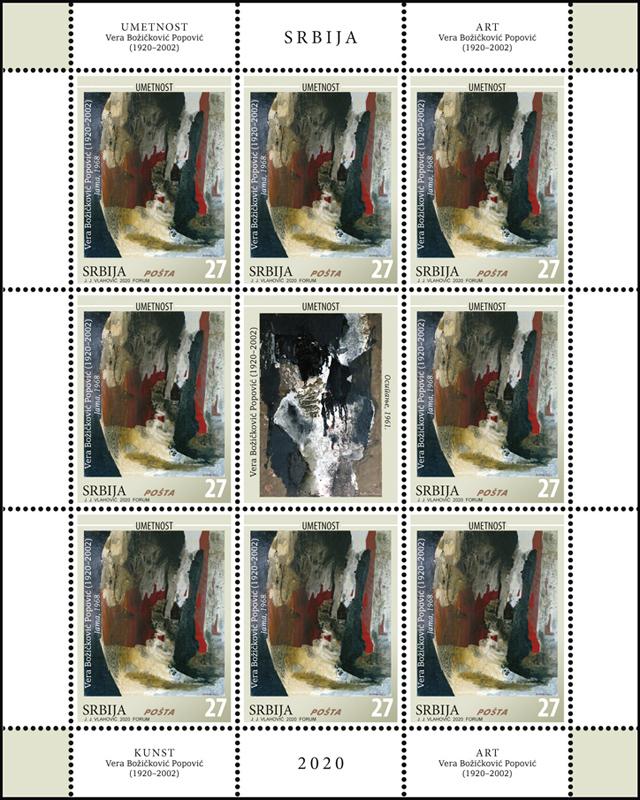





Petar Dobrović (Pécs, 1890 – Belgrade, 1942) was one of the most important painters belonging to the 20th century civic modernism movement. He took active participation in the avant-garde movement and social and political engagement both before and after the First World War, which is in his art reflected by artworks on social themes. Style-wise, his art departs from Cézannesque and cubist to constructivist to most important works in the spirit of the colourist expressionism. Mediterranean landscapes, olive groves, fruits, sea, nudes, were the themes where he demonstrated his virtuosic expression by colour, by which, in a manner of a true master, he materialised the light and atmosphere of the Mediterranean. On the other hand, he is also known for a large number of portraits through which, in addition to artistic quality, he showed a masterly representation of character of the portraited person.
Motif on stamp: Old Bepo, oil/canvas, 1940. Motif on vignette: Villas on Hvar, oil/canvas, 1933. Motif on envelope: Vegetables (Still Life II, with Peppers), oil/cardboard, 1928.
Vera Božičković Popović (Brčko, 1920 – Belgrade, 2002) graduated from the Visual Art Academy in Belgrade in the class of Professor Ivan Tabaković. During the studies, together with her class peers, she was a member of the “Zadar Group” (1947) whose activity directly pointed to the deficiencies of the academic way of education and to the issues of artistic freedom. She was one of the distinguished members of the Belgrade Informalism. Within the Informalism movement, she experimented with a variety of materials of a non-painting origin, which enabled her to create a basic imagery, based on elementary scenes such as canyons, gullies, grooves, ruts and other natural forms. Through her research in Informalism, she as an artist grew into full artistic maturity by constructing a specific expressive phrase where she realised the top of her artistic achievements.
Motif on stamp: The Pit, mixed technique/canvas, 1968. Motif on vignette and envelope: Dispersal, mixed technique/canvas, 1961.
Kosta Bogdanović (Ilidža, 1930 – Belgrade, 2012) was a sculptor, art historian, custodian, theoretician and pedagogue. He worked in the Museum of Modern Art as a custodian from 1967 to 1994 and was its acting director from 1985 to 1987. He was a fellow of the Academies of Art in Novi Sad and Sarajevo. On the basis of his research, he founded the courses of Visual Culture which he taught in Sarajevo and Visual Culture Theory in Novi Sad. All these engagements and interests were united and served one goal: to understand the artistic creativity process. The theory of form developed by Bogdanović, about which he wrote and taught extensively, found its personification in his works. Combination of natural forms, various materials and ancient cultures was characterised in his works by a specific and authentic expression with high artistic achievement.
Motif on stamp: Home organ, painted wood (maple), 2008. Motif on vignette: View from above, painted cast iron, 1990. Motif on envelope: Forma-japanika III, painted wood (maple), 2007
Leonid Šejka (Belgrade, 1932 – Belgrade, 1970) was an artist and art theoretician. He was one of the founders and theoreticians of the Mediala group. Šejka made a specific and unique occurrence at the artistic stage of the fifties and the sixties. He was the first in his community to understand that the artistic act is also possible outside the aesthetic object (the first hint to mental art and behavioural art), and the first to invoke the great museal art of the past, quoting the signs and forms of other artists from various periods (which became, much later, a characteristic of “learned painting” and postmodern age).
Motif on stamp: Museum exhibition, oil/canvas, 1956. Motif on vignette and envelope: Multiplication, oil/canvas, 1956.
Expert collaboration: Aleksandra Mirčić, Head of the Department of Art Documentation, Museum of Contemporary Art
Graphic realisation of the issue: MA Jakša Vlahović, Academic Graphic Artist.
250th Anniversary of the Birth of Ludwig van Beethoven




Ludwig van Beethoven (Bonn, 1770 – Vienna, 1827) was a German composer, one of the greatest composers of all time. His impressive music opus includes, among other, nine symphonies, 16 pieces for string quartets, 32 piano sonatas, one opera, two masses, five piano and one violin concertos. Particularly striking are his Symphony No. 5, Symphony No. 6, Symphony No. 9, Missa Solemnis, piano pieces such as Für Elise, Sonata Pathétique, Moonlight Sonata, Apassionata or The Last One.
Ludwig van Beethoven was born in Bonn, Germany, to father Johann who was the Bonn court musician and mother Magdalena Keverich. Thanks to his father, he started to play at an early age, first as a piano performer. He quickly gained the reputation of a piano virtuoso and master of improvisation. His artistic form was very expressive, impetous and emotional, nearly perfect, but because of his misfortune – gradual hearing loss that started when Beethoven was 26 – he had to end his pianistic career. Although he composed his Symphony No. 1 before 1800 while still performing as a pianist, his deafness progressed in 1802 to the extent that Beethoven became increasingly isolated and avoided people; he even communicated with friends through notebooks which, after his death, were printed out and sold.
Just like other composers of his time, Beethoven created under the influence of the then popular and folk music, so that the motifs of dance rhythms from the Rhein area and the elements of Italian, French, and even Celtic folk music, can be detected in his works. Although as a composer he “relied” on the tradition of Haydn (who was his music teacher for some time) and Mozart, his art aspires towards the new, romanticist ideals of Goethe and Schiller striving, just like their books, to balance form and feelings.
Beethoven created the greatest masterpieces in his world of silence: Missa Solemnis, Hammerklavier Sonata, the last String Quartets, and in 1824 he completed his Symphony No. 9 on which he had worked since 1817, and which crowned his musical opus in the truest sense of the word. The famous Symphony No. 9 was premiered in Vienna on 7 May 1824, and Beethoven, although totally deaf, personally conducted at that first performance, completely unaware of the applause, until the moment when the soloists turned him towards the audience. He died in Vienna in 1827.
Artistic realization of the issue: MA Boban Savić, academic painter.